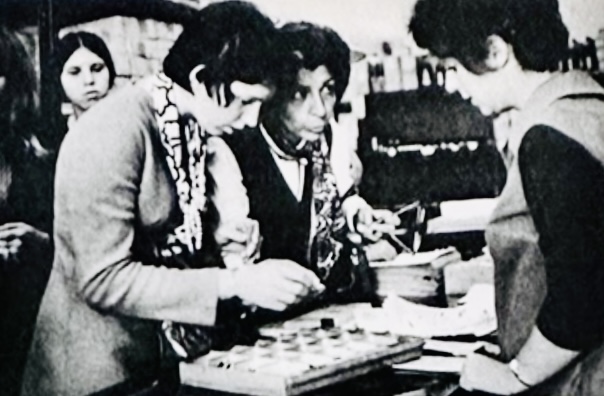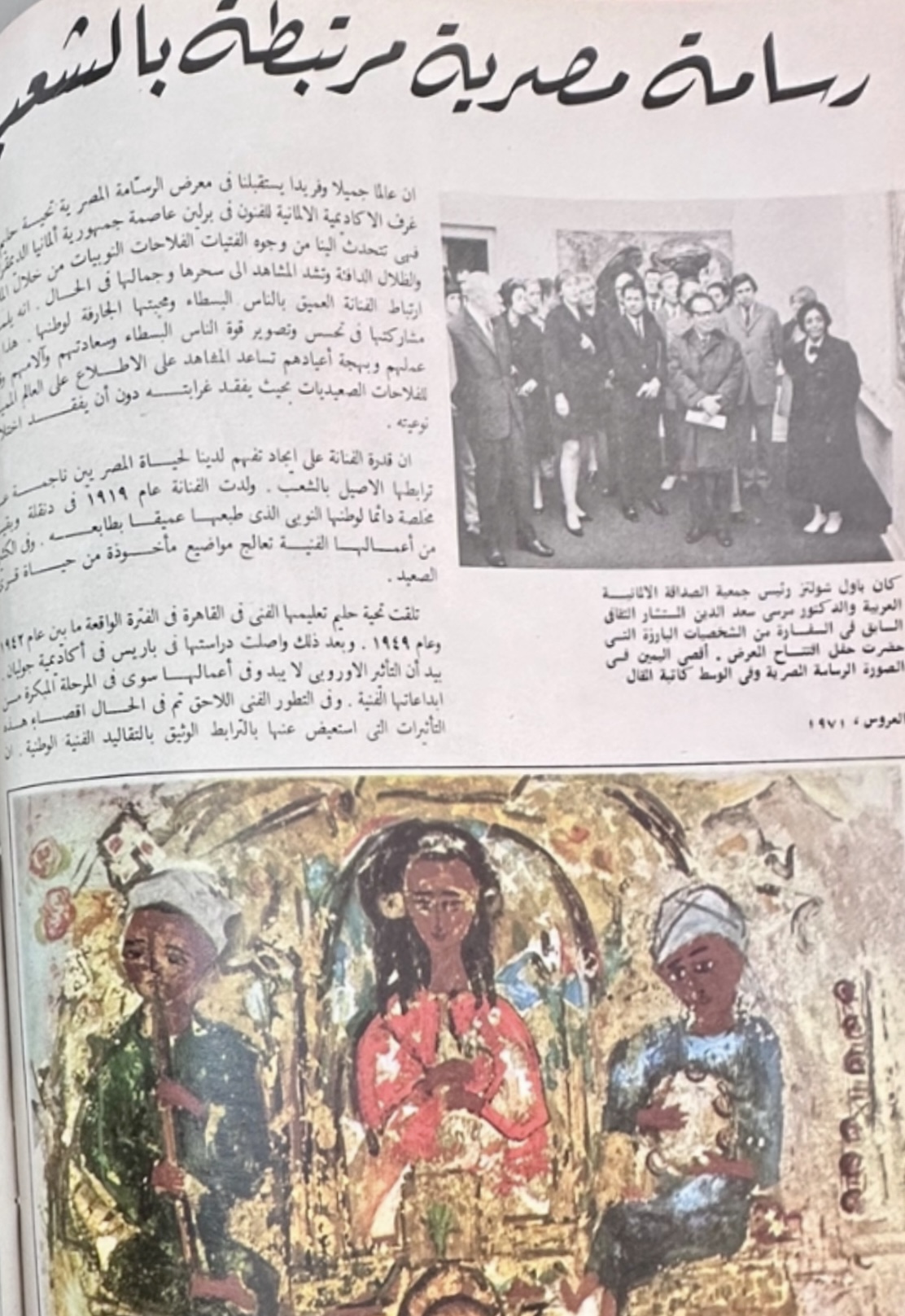Between the Peace Advocate and the Patriot: How al-Majallah Celebrated Inji Efflatoun and Tahia Halim’s Exhibitions in the GDR and Beyond
- 1970
- 1971
- Inji Efflatoun
- Tahia Halim
Guest contribution by Art Historian Hala Ghoname
“But the most important thing, in my opinion, is that these images of the life of the people, of simple people and simple scenes, are not folkloric drawings or quiet, contemplative performances depicting acts and events from everyday life, but they show a flowing strength, a deep love for the homeland, and a broad knowledge of the life and spirit of the people. These works are living testimonies of those noble human emotions that Inji Efflatoun demonstrated - with courage and sincerity - in her political life.”
With these words of appreciation for Inji Efflatoun’s paintings, said by none other than the renowned Italian painter Renato Guttuso (1912-1987), al-Majallah celebrated the Egyptian artist’s exhibition in Dresden in 1970. Among the GDR’s long publishing, nonetheless, scarcely-examined means of cultural propaganda tabloids was the Dresden-based Arabic magazine al-Majallah: Ṣaḥifa Muṣauwara min Jumhūrīyat Almāniyā al-Dimūqrāṭīya (The Magazine: An Illustrated Newspaper from the German Democratic Republic). The GDR sponsored this Arabic-language journal from 1959 to 1990; it was supported by the Freundschaftsgesellschaft DDR - Arabische Länder and published by Deutsch-Arabische Gesellschaft in der DDR (FID/MENALIB, 2022). Distributed both locally and in the Arab countries of Egypt, Iraq, Lebanon, Syria, Tunisia, Sudan, and Algeria, one of the many aspects that distinguish this tabloid was it being a product of German natives and intellectuals who were well-versed in Middle-Eastern languages, not by Arabs who had lived in the GDR.
As a cultural politics tabloid, al-Majallah provided vibrant and detailed documentation of the art movement in East Germany during its three decades of existence. This is clearly explicit in the tracing of exhibitions, artistic expeditions, and interviews with German, Arab, Latin American, African, and Asian artists in the GDR and beyond. Moreover, the tabloid offered a great source of data not only on Arab artist expats and visitors of the GDR but also on Arab art students in the eastern state, with special attention given to those who had pursued their artistic education at East German universities, or those who were highly celebrated as “artists of the people”.
Inji Efflatoun (1924-1989) was one of those artists; she was an Egyptian painter, a feminist, and an activist who had started her political career as a member of the communist organization in Egypt Iskra/al-Sharārah in 1942 and co-formed the feminist and anti-colonialist young women league “Ligue des jeunes femmes des universités et des instituts” by the middle of 1945 (Osman, 2021, p. 12). In the 1950s, Efflatoun’s works started to focus on the lives of marginalized peasants and the working class, inclining towards a more socialist realism nature (Turk, 2019, p. 40). Equally admired as a peace advocate, the title of the al-Majallah article was “Inji Efflatoun’s paintings captured the attention of the Friends of Arts in the German Democratic Republic”. The tabloid described how the citizens, labeled as “art friends from the German Democratic Republic”, had the opportunity to get acquainted with a series of the most important works of art created by the famous Arab artist.

According to al-Majallah, the works of Efflatoun were displayed at the Kulturpalast Dresden and in the picture gallery known as the Neue Berliner Galerie. The exhibition catalog indicates that 48 paintings of Efflatoun were displayed from the 8th to the 25th of September 1970. The works mainly focused on rural life, depicting scenes of women, peasants, workers, and sights from daily life in the Egyptian countryside. Moreover, several paintings reflected the artists own imprisonment experience from 1959-1963, as part of a wave of arrests by the Nasserist regime against communist figures, such as the painting with the title “Kauernde Frauen” dated 1960 (Ministerium für Kultur, 1970). The intensively illustrated article of al-Majallah showed not only examples of Efflatoun’s art but also the artist herself engaged in explaining her paintings to the visitors and even her trip to a local art store in Dresden to purchase supplies. Notably, the article extensively highlights how the 'East German art friends' were fascinated by “the unique charm of such paintings”, which had been based on the fact that Inji Efflatoun - and this was what she herself said – “searched for her artistic subjects and always found them in Egyptian nature and the people who live there in it”. Furthermore, according to al-Majallah, “the citizens of the German Democratic Republic saw also in the Egyptian painter a brave woman and a member of the World Peace Council, who defended peace and progress with all her might” (al-Majallah, 1971, p. 9).

Five years later, the designation of the 'peace advocate' continued to underscore the treasured socialist attributes of Efflatoun, as al-Majallah documented another exhibition in which she had participated; however, this time was at the German Democratic Republic Cultural and Media Center in Cairo. The title of the reportage was “A message from Cairo: Disarmament for whose benefit?”. Efflatoun, the peace advocate and member of the World Peace Council, was shown leading the tours at the exhibition and explaining the works to Khālid Muḥyī al-Dīn, the Chairman of the World Peace Council in Egypt, as well as Reiner Neumann, the East German Ambassador to Cairo (Skilands, 1976, p. 28).

For decades, Efflatoun was believed to have been the only female artist from Egypt who exhibited her works in the GDR. However, al-Majallah denoted a different fact about her fellow Egyptian artist Tahia Halim (1919-2003). Halim had also displayed her paintings in the East German capital of Berlin. In an extended reportage titled “An Egyptian Painter Concerned with the People”, al-Majallah presented an overview of Halim’s exhibition, which was held at the Art Academy in Berlin during the winter of 1971-1972 and gained remarkable recognition. Karin Rohden, the article's author, started it by describing what she called “a beautiful and unique world that welcomed the visitors of the exhibition of Tahia Halim in Berlin”. Rohden emphasized how the works of Halim had communicated a sense of belonging and patriotism through the “magical beauty and warm shades on the faces of the artist’s portraits of peasants and Nubian girls” (Rohden, 1972, p. 42).

Moreover, through an overview of the artist’s biography, the article celebrated Halim’s socialist patriotism and commitment towards the cause of her people, valuing the inherited legacy and artistic tradition, and declining bourgeoisie trends in art. Fittingly, Halim’s adapting to these models contributed - to a large extent - to enabling the artist to develop her own distinguished style, which is, according to the author “very original, free from any tendency towards popular formal influences, and this is what makes her different from some of her colleagues; especially, those who were carried away by the "modernism" currents of late bourgeois art. The use of traditional stylistic elements is not at all linked to trivial formalisms but rather displays a later creative development based on the suggestions that the artist was inspired by a patriotic artistic tradition” (Rohden, 1972, p. 43).
Ultimately, for the GDR and through the pages of al-Majallah, Inji Efflatoun and Tahia Halim represented ideal examples of the “socialist patriot artists”. The two painters presented a living commitment to the propagated message of art, which was described by the Dresdner artist and Chairman of the Fine Artists Union, Gerhard Bondzin, also through the pages of the same tabloid, in which he emphasized the importance of art in “protecting world peace, conveying solidarity with nations striving to attain their freedom, and promoting the beauty of the socialist ideology”. Bondzin’s comment was made during the Seventh GDR Art Exhibition covered by al-Majallah and titled "Positive Attitude in Art," (Bondzin, 1973, p. 2).
For further information:
al-Majallah, 1971. Inji Efflatoun 's paintings captured the attention of the Friends of Arts in the German Democratic Republic. al-Majallah: Ṣaḥifa Muṣauwara min Jumhūrīyat Almāniyā ad-Dimūqrāṭīya, Issue 1, pp. 8-9.
Bondzin, G., 1973. Positive Attitude in Art. al-Majallah: Ṣaḥifa Muṣauwara min Jumhūrīyat Almāniyā ad-Dīmūqrāṭīya / The Magazine: An Illustrated Newspaper from the German Democratic Republic, 1 January.pp. 2-6.
FID/MENALIB. (2022, January 11). MENALIB. Retrieved from Twitter: https://twitter.com/menalib/status/1480908219878973444?s=20&fbclid=IwAR0uZWr22_SkcvBZSEOgK5Jm4EQBRctbYJaHepadJjn_ovGLCJ9RTibfezk
Ministerium für Kultur, 1970. Inji Efflatoun: Vereinigte Arabische Republik Malerei. 1st ed. Berlin: Ministerium für Kultur.
Osman, M., 2021. Inji Efflatoun: Between the Revolutionary and Subjectivity. 1st ed. Cairo: The Egyptian Public Commission of Books.
Rohden, K., 1972. An Egyptian Painter Concerned with the People. al-Majallah: Ṣaḥifa Muṣauwara min Jumhūrīyat Almāniyā ad-Dimūqrāṭīya , Issue 5, pp. 42-43.
Skilands, S., 1976. A message from Cairo: Disarmament for whose benefit. al-Majallah: Ṣaḥifa Muṣauwara min Jumhūrīyat Almāniyā ad-Dimuqrāṭīya, Issue 1, p. 28.
Turk, S. d., 2019. Street Art in the Middle East. 1st ed. London: I.B. Tauris.
